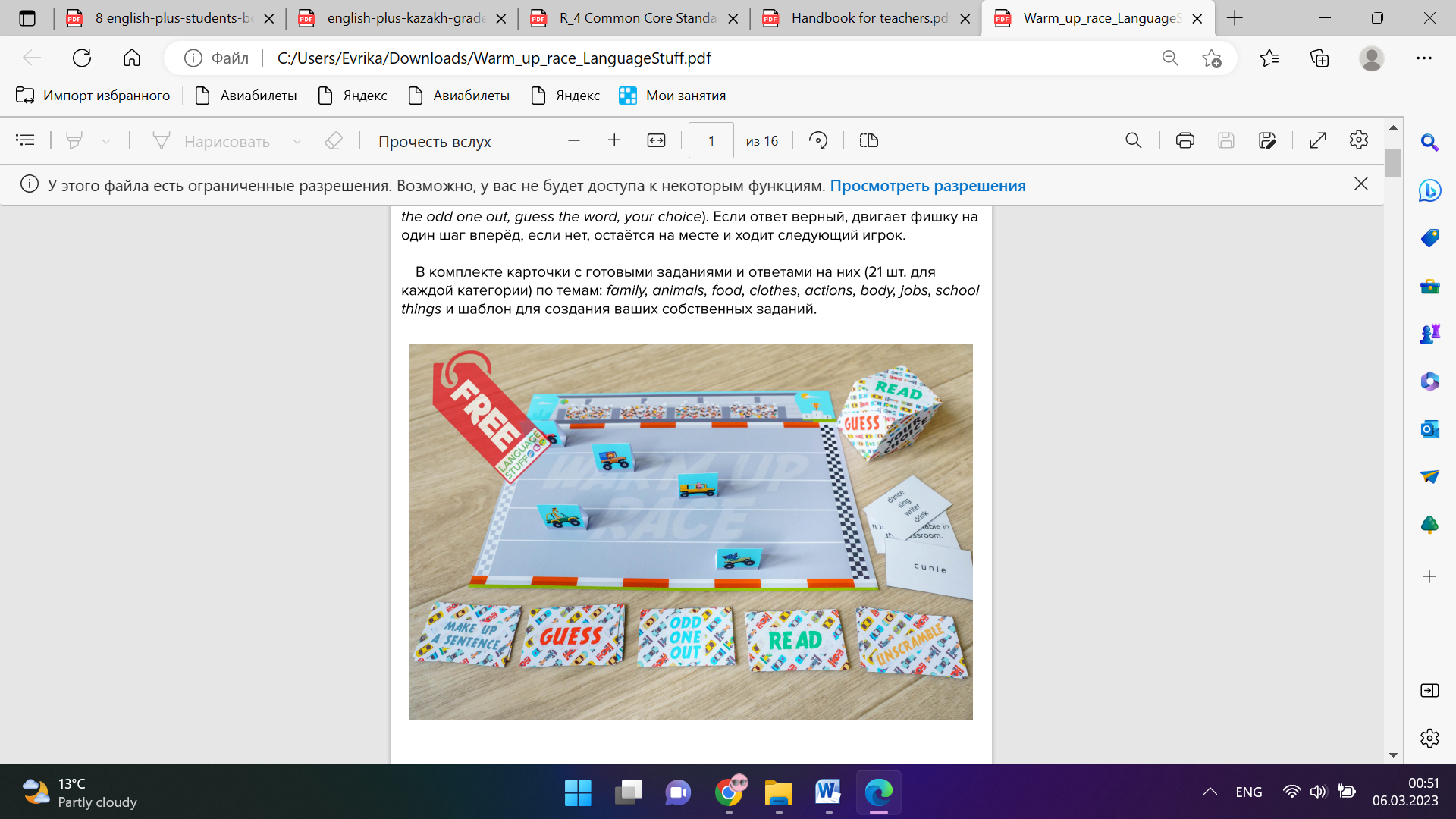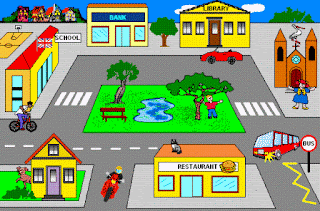
Short term plan: term 4
|
Unit 8 Our neighbourhood |
|
||
|
Teacher name: |
|
||
|
Date: |
|
||
|
Grade: 6 |
Number present: |
absent: |
|
|
Lesson title |
Places in a town |
||
|
Learning objectives |
6.2.5.1 understand most specific information and detail of short, supported talk on a wide range of familiar topics curricular topics. 6.1.8.1 develop intercultural awareness through reading and discussion 6.6.14.1 use prepositions to talk about time and location use prepositions like to describe things and about to denote topic use prepositions of direction to, into, out of, from, towards on a limited range of familiar general and curricular topics familiar general and curricular topics |
||
|
Lesson objectives |
Learners will be able to: • Learn vocabulary for places in a town. • Learn there is … , there are … with a, an, some and any to talk about a town. • Write sentences about a town. |
||
|
Value links |
Hospitality: Traditionally a nomadic culture, hospitality has always been an important part of Kazakh culture. |
||
|
Plan |
|||
|
Stages / Time |
Teachers’ actions |
Students’ actions |
Assessment criteria |
Resources |
|
Beginning of the lesson 5 min |
Organization moment 1.Greeting. Ask about the weather. The teacher sets the lesson objectives, letting students know what to anticipate from the lesson. Warm-up
Fasten your seat belts and get ready for the all-round race Lead – In • With books closed, ask students: Do you live in a town or in the country? • Ask: What can you find in a town? Try to elicit some words for places in a town, e.g. shops, cinema |
Students' attention is drawn to the lesson. Students discuss the pictures in pairs. Determines the topic and aim of the lesson Students say different words from the picture |
Formative Assessment
Good job! Assessment criteria -Identify detailed information in extended conversation with support |
Pictures Student’s book |
|
Middle of the lesson Presentation part. 35 min |
Ex: 1 P:92 • Refer students to the picture on page 19. They match the words individually, then compare their answers in pairs. • Students listen and check their answers. • Drill the pronunciation of the words. • In a weaker class, check understanding of the words in the box and advise students to write translations of each word in their notebooks
Ex: 2 P:92 • Remind students to listen carefully for clues about where each speaker might be. • Ask students to check their answers in pairs. • If students disagree about their answers, play the CD again so that they can check. Ex: 3 P:92 • Point out the labels A–D on the map of the city. Refer students to the texts below the picture, and explain that each text describes the relevant area on the map. • Allow students time to read the texts and the options carefully, and choose option a or b Conclusion during the lesson some tasks differentiated by outcomes of the students and by their abilities. |
Students match twelve of the words in the box with places. Answers: 1 train station 2 factory 3 flats 4 park 5 shopping centre 6 offices 7 shops 8 school 9 sports centre 10 restaurant 11 river 12 car park Differentiation: «Verbal support» method is used to help Students use new words in the text. Students listen and answer the question. Where are the people in situations? Answers: 1 park 2 library 3 train station 4 restaurant 5 sports centre 6 factory 7 school 8 cinema Students work in pairs. Read the information. Answers: A a: This is a good place for the bus station. B a: This is a good place for the cinema. C a: This is a good place for the library. D b: This is a good place for the hospital. |
Descriptor: - match twelve of the words - work in pairs Total: 1 point Descriptor: -listen the task -answer the question Total: 1 point Descriptor: - gives information about himself/herself; Total: 1 point |
Cards Worksheets |
|
End of the lesson 5 min |
FEEDBACK Learners provide feedback on what they have learned at the lesson. |
|
Students evaluate each other and encourage classmate with phrases like: Well done! Brilliant! Good job! I like it! . |
Poster
|
Short term plan: term 4
|
Unit 8 Our neighbourhood |
|
||
|
Teacher name: |
|
||
|
Date: |
|
||
|
Grade: 6 |
Number present: |
absent: |
|
|
Lesson title |
Reading: A description of a modern city |
||
|
Learning objectives |
6.1.1.1 use speaking and listening skills to solve problems creatively and cooperatively in groups 6.2.5.1 understand most specific information and detail of short, supported talk on a wide range of familiar topics 6.3.7.1 use appropriate subject-specific vocabulary and syntax to talk about a limited range of general topics |
||
|
Lesson objectives |
Learners will be able to: • Read about some interesting buildings. • Find spelling rules for plural nouns. • Talk about your town. |
||
|
Value links |
Tradition: Kazakh traditions and culture have been passed on from one generation to another through oral histories told by traditional Kazakh tribal leaders and elders. |
||
|
Plan |
|||
|
Stages / Time |
Teachers’ actions |
Students’ actions |
Assessment criteria |
Resources |
|
Beginning of the lesson 5 min |
Organization moment 1.Greeting. Ask about the weather. The teacher sets the lesson objectives, letting students know what to anticipate from the lesson. Warm-up
Fasten your seat belts and get ready for the all-round race Lead – In • Ask students to look at the photo on page 20 and the title of the text. Ask students to try to guess where this city is, but do not tell them whether they are right or not. • Elicit some ideas and write them on the board. • Pre-teach the words floor (a building with three floors), gym and lake. |
Students' attention is drawn to the lesson. Students discuss the pictures in pairs. Determines the topic and aim of the lesson Students say different words from the picture |
Formative Assessment
Good job! Assessment criteria -Identify detailed information in extended conversation with support |
Pictures Student’s book |
|
Middle of the lesson Presentation part. 35 min |
Ex: 1 P:94 • Before students read the text, ask them to look at the photos and read the words in the box. Remind them that photos can help them interpret a text, and give them useful clues about the content. • Check understanding of the words in the box. In a stronger class, ask one or two students to say which words they chose and why. • When students have listened, discuss the words again and check their answer from the warm-up activity Ex: 2 P:94 • Allow students time to read the sentences carefully before they answer true or false. In a weaker class, they can complete this activity in pairs. • Check answers with the class. Ask students to identify the area of the text where they found the answer Ex: 3 P:94 • Refer students to the text, and explain that the plural forms of the nouns in the box can all be found in the text. In a stronger class, ask students to close their books while you check the answers. • Ask students when the -ies form is used. Elicit answers from individual students. Conclusion during the lesson some tasks differentiated by outcomes of the students and by their abilities. |
Students look at the photos and choose six words that you can use to describe the building. Then read, listen and check your answers. Answers: Not mentioned: museum, mountains Differentiation: «Verbal support» method is used to help Students use new words in the text. Students read the text again and write true or false. Correct the false sentences. Answers: 1 False. You can see the Burj Khalifa from 100 kilometres away. 2 False. The skyscraper is a modern building. 3 False. There are 900 flats in the skyscraper. 4 True. 5 False. The lifts in the tower are very fast Students find the plural forms of these words in the text. When do we form a plural with -ies Answers: offices, cities, flats, parks, shops, libraries We usually form a plural with -ies when the noun ends in consonant + -y. We change the -y to -i and add -es. |
Descriptor: - read the text - choose six words to describe the building Total: 1 point Descriptor: - read the text - write true or false Total: 1 point Descriptor: - find the plural forms Total: 1 point |
Cards Worksheets |
|
End of the lesson 5 min |
FEEDBACK Learners provide feedback on what they have learned at the lesson. |
|
Students evaluate each other and encourage classmate with phrases like: Well done! Brilliant! |
Poster
|
Short term plan: term 4
|
Unit 8 Our neighbourhood |
|
||
|
Teacher name: |
|
||
|
Date: |
|
||
|
Grade: 6 |
Number present: |
absent: |
|
|
Lesson title |
Language Focus. Is there/ Are there |
||
|
Learning objectives |
6.3.7.1 use appropriate subject-specific vocabulary and syntax to talk about a limited range of general topics general and curricular topics 6.6.14.1 use prepositions to talk about time and location use prepositions like to describe things and about to denote topic use prepositions of direction to, into, out of, from, towards and there is / there are on a limited range of familiar general and curricular topics familiar general and curricular topics |
||
|
Lesson objectives |
Learners will be able to: • Learn and use the question forms Is there …? and Are there …? with the appropriate short answers. • Use key phrases to express quantity. • Describe an ideal place to live. |
||
|
Value links |
Freedom: Freedom is the major value of the civil society being formed in Kazakhstan. This must provide everyone with the possibility of creative self-realization. |
||
|
Plan |
|||
|
Stages / Time |
Teachers’ actions |
Students’ actions |
Assessment criteria |
Resources |
|
Beginning of the lesson 5 min |
Organization moment 1.Greeting. Ask about the weather. The teacher sets the lesson objectives, letting students know what to anticipate from the lesson. Warm-up
Fasten your seat belts and get ready for the all-round race Lead – In • Tell students to imagine they are visiting a new town or city. • Tell them that they need to find out whether there is a cinema in the town. Elicit the question they would ask, and write it on the board: Is there a cinema in this town? |
Students' attention is drawn to the lesson. Students discuss the pictures in pairs. Determines the topic and aim of the lesson Students say different words from the picture |
Formative Assessment
Good job! Assessment criteria -Identify detailed information in extended conversation with support |
Pictures Student’s book |
|
Middle of the lesson Presentation part. 35 min |
Ex: 1 P:95 • Refer students back to page 20. Point out that they should study the question forms in exercise 5 to complete the first part of the activity, then read the text again if necessary to answer each question. In a stronger class, encourage them to do this from memory. Ex: 2 P:95 • In a weaker class, allow students to complete the rules in pairs. Refer students back to exercise 1 for support. You may need to highlight the singular and plural nouns in the questions LANGUAGE NOTE To form questions from there is / there are we
put the verb first: Is there …? / Are there …?: Is there a swimming
pool? NOT Ex: 3 P:95 • In a weaker class, tell students to circle the nouns to help them form the questions correctly. • Go round and listen as they are talking. Check that they are using short answers correctly Conclusion during the lesson some tasks differentiated by outcomes of the students and by their abilities. |
Students complete the questions. Then match the questions with answers Answers: 1 any, b 2 are, a 3 Is, c Differentiation: «Verbal support» method is used to help Students use new words in the text. Students choose the correct answers Answers: 1 any 2 singular nouns 3 plural nouns Students complete the questions with is there / are there. Then ask and answer with a partner. Give short answer. Answers: 1 Is there 2 Are there 3 Are there 4 Is there 5 Are there 6 Are there 7 are there 8 are there Students’ own answers |
Descriptor: - read the text - match the questions with answers Total: 1 point Descriptor: - complete the rules - choose the correct answers Descriptor: - complete the questions - give short answer Total: 1 point |
Cards Worksheets |
|
End of the lesson 5 min |
FEEDBACK Learners provide feedback on what they have learned at the lesson. |
|
Students evaluate each other and encourage classmate with phrases like: Well done! Brilliant! |
Poster
|
жүктеу мүмкіндігіне ие боласыз
Бұл материал сайт қолданушысы жариялаған. Материалдың ішінде жазылған барлық ақпаратқа жауапкершілікті жариялаған қолданушы жауап береді. Ұстаз тілегі тек ақпаратты таратуға қолдау көрсетеді. Егер материал сіздің авторлық құқығыңызды бұзған болса немесе басқа да себептермен сайттан өшіру керек деп ойласаңыз осында жазыңыз
Places in a town
Places in a town
Short term plan: term 4
|
Unit 8 Our neighbourhood |
|
||
|
Teacher name: |
|
||
|
Date: |
|
||
|
Grade: 6 |
Number present: |
absent: |
|
|
Lesson title |
Places in a town |
||
|
Learning objectives |
6.2.5.1 understand most specific information and detail of short, supported talk on a wide range of familiar topics curricular topics. 6.1.8.1 develop intercultural awareness through reading and discussion 6.6.14.1 use prepositions to talk about time and location use prepositions like to describe things and about to denote topic use prepositions of direction to, into, out of, from, towards on a limited range of familiar general and curricular topics familiar general and curricular topics |
||
|
Lesson objectives |
Learners will be able to: • Learn vocabulary for places in a town. • Learn there is … , there are … with a, an, some and any to talk about a town. • Write sentences about a town. |
||
|
Value links |
Hospitality: Traditionally a nomadic culture, hospitality has always been an important part of Kazakh culture. |
||
|
Plan |
|||
|
Stages / Time |
Teachers’ actions |
Students’ actions |
Assessment criteria |
Resources |
|
Beginning of the lesson 5 min |
Organization moment 1.Greeting. Ask about the weather. The teacher sets the lesson objectives, letting students know what to anticipate from the lesson. Warm-up
Fasten your seat belts and get ready for the all-round race Lead – In • With books closed, ask students: Do you live in a town or in the country? • Ask: What can you find in a town? Try to elicit some words for places in a town, e.g. shops, cinema |
Students' attention is drawn to the lesson. Students discuss the pictures in pairs. Determines the topic and aim of the lesson Students say different words from the picture |
Formative Assessment
Good job! Assessment criteria -Identify detailed information in extended conversation with support |
Pictures Student’s book |
|
Middle of the lesson Presentation part. 35 min |
Ex: 1 P:92 • Refer students to the picture on page 19. They match the words individually, then compare their answers in pairs. • Students listen and check their answers. • Drill the pronunciation of the words. • In a weaker class, check understanding of the words in the box and advise students to write translations of each word in their notebooks
Ex: 2 P:92 • Remind students to listen carefully for clues about where each speaker might be. • Ask students to check their answers in pairs. • If students disagree about their answers, play the CD again so that they can check. Ex: 3 P:92 • Point out the labels A–D on the map of the city. Refer students to the texts below the picture, and explain that each text describes the relevant area on the map. • Allow students time to read the texts and the options carefully, and choose option a or b Conclusion during the lesson some tasks differentiated by outcomes of the students and by their abilities. |
Students match twelve of the words in the box with places. Answers: 1 train station 2 factory 3 flats 4 park 5 shopping centre 6 offices 7 shops 8 school 9 sports centre 10 restaurant 11 river 12 car park Differentiation: «Verbal support» method is used to help Students use new words in the text. Students listen and answer the question. Where are the people in situations? Answers: 1 park 2 library 3 train station 4 restaurant 5 sports centre 6 factory 7 school 8 cinema Students work in pairs. Read the information. Answers: A a: This is a good place for the bus station. B a: This is a good place for the cinema. C a: This is a good place for the library. D b: This is a good place for the hospital. |
Descriptor: - match twelve of the words - work in pairs Total: 1 point Descriptor: -listen the task -answer the question Total: 1 point Descriptor: - gives information about himself/herself; Total: 1 point |
Cards Worksheets |
|
End of the lesson 5 min |
FEEDBACK Learners provide feedback on what they have learned at the lesson. |
|
Students evaluate each other and encourage classmate with phrases like: Well done! Brilliant! Good job! I like it! . |
Poster
|
Short term plan: term 4
|
Unit 8 Our neighbourhood |
|
||
|
Teacher name: |
|
||
|
Date: |
|
||
|
Grade: 6 |
Number present: |
absent: |
|
|
Lesson title |
Reading: A description of a modern city |
||
|
Learning objectives |
6.1.1.1 use speaking and listening skills to solve problems creatively and cooperatively in groups 6.2.5.1 understand most specific information and detail of short, supported talk on a wide range of familiar topics 6.3.7.1 use appropriate subject-specific vocabulary and syntax to talk about a limited range of general topics |
||
|
Lesson objectives |
Learners will be able to: • Read about some interesting buildings. • Find spelling rules for plural nouns. • Talk about your town. |
||
|
Value links |
Tradition: Kazakh traditions and culture have been passed on from one generation to another through oral histories told by traditional Kazakh tribal leaders and elders. |
||
|
Plan |
|||
|
Stages / Time |
Teachers’ actions |
Students’ actions |
Assessment criteria |
Resources |
|
Beginning of the lesson 5 min |
Organization moment 1.Greeting. Ask about the weather. The teacher sets the lesson objectives, letting students know what to anticipate from the lesson. Warm-up
Fasten your seat belts and get ready for the all-round race Lead – In • Ask students to look at the photo on page 20 and the title of the text. Ask students to try to guess where this city is, but do not tell them whether they are right or not. • Elicit some ideas and write them on the board. • Pre-teach the words floor (a building with three floors), gym and lake. |
Students' attention is drawn to the lesson. Students discuss the pictures in pairs. Determines the topic and aim of the lesson Students say different words from the picture |
Formative Assessment
Good job! Assessment criteria -Identify detailed information in extended conversation with support |
Pictures Student’s book |
|
Middle of the lesson Presentation part. 35 min |
Ex: 1 P:94 • Before students read the text, ask them to look at the photos and read the words in the box. Remind them that photos can help them interpret a text, and give them useful clues about the content. • Check understanding of the words in the box. In a stronger class, ask one or two students to say which words they chose and why. • When students have listened, discuss the words again and check their answer from the warm-up activity Ex: 2 P:94 • Allow students time to read the sentences carefully before they answer true or false. In a weaker class, they can complete this activity in pairs. • Check answers with the class. Ask students to identify the area of the text where they found the answer Ex: 3 P:94 • Refer students to the text, and explain that the plural forms of the nouns in the box can all be found in the text. In a stronger class, ask students to close their books while you check the answers. • Ask students when the -ies form is used. Elicit answers from individual students. Conclusion during the lesson some tasks differentiated by outcomes of the students and by their abilities. |
Students look at the photos and choose six words that you can use to describe the building. Then read, listen and check your answers. Answers: Not mentioned: museum, mountains Differentiation: «Verbal support» method is used to help Students use new words in the text. Students read the text again and write true or false. Correct the false sentences. Answers: 1 False. You can see the Burj Khalifa from 100 kilometres away. 2 False. The skyscraper is a modern building. 3 False. There are 900 flats in the skyscraper. 4 True. 5 False. The lifts in the tower are very fast Students find the plural forms of these words in the text. When do we form a plural with -ies Answers: offices, cities, flats, parks, shops, libraries We usually form a plural with -ies when the noun ends in consonant + -y. We change the -y to -i and add -es. |
Descriptor: - read the text - choose six words to describe the building Total: 1 point Descriptor: - read the text - write true or false Total: 1 point Descriptor: - find the plural forms Total: 1 point |
Cards Worksheets |
|
End of the lesson 5 min |
FEEDBACK Learners provide feedback on what they have learned at the lesson. |
|
Students evaluate each other and encourage classmate with phrases like: Well done! Brilliant! |
Poster
|
Short term plan: term 4
|
Unit 8 Our neighbourhood |
|
||
|
Teacher name: |
|
||
|
Date: |
|
||
|
Grade: 6 |
Number present: |
absent: |
|
|
Lesson title |
Language Focus. Is there/ Are there |
||
|
Learning objectives |
6.3.7.1 use appropriate subject-specific vocabulary and syntax to talk about a limited range of general topics general and curricular topics 6.6.14.1 use prepositions to talk about time and location use prepositions like to describe things and about to denote topic use prepositions of direction to, into, out of, from, towards and there is / there are on a limited range of familiar general and curricular topics familiar general and curricular topics |
||
|
Lesson objectives |
Learners will be able to: • Learn and use the question forms Is there …? and Are there …? with the appropriate short answers. • Use key phrases to express quantity. • Describe an ideal place to live. |
||
|
Value links |
Freedom: Freedom is the major value of the civil society being formed in Kazakhstan. This must provide everyone with the possibility of creative self-realization. |
||
|
Plan |
|||
|
Stages / Time |
Teachers’ actions |
Students’ actions |
Assessment criteria |
Resources |
|
Beginning of the lesson 5 min |
Organization moment 1.Greeting. Ask about the weather. The teacher sets the lesson objectives, letting students know what to anticipate from the lesson. Warm-up
Fasten your seat belts and get ready for the all-round race Lead – In • Tell students to imagine they are visiting a new town or city. • Tell them that they need to find out whether there is a cinema in the town. Elicit the question they would ask, and write it on the board: Is there a cinema in this town? |
Students' attention is drawn to the lesson. Students discuss the pictures in pairs. Determines the topic and aim of the lesson Students say different words from the picture |
Formative Assessment
Good job! Assessment criteria -Identify detailed information in extended conversation with support |
Pictures Student’s book |
|
Middle of the lesson Presentation part. 35 min |
Ex: 1 P:95 • Refer students back to page 20. Point out that they should study the question forms in exercise 5 to complete the first part of the activity, then read the text again if necessary to answer each question. In a stronger class, encourage them to do this from memory. Ex: 2 P:95 • In a weaker class, allow students to complete the rules in pairs. Refer students back to exercise 1 for support. You may need to highlight the singular and plural nouns in the questions LANGUAGE NOTE To form questions from there is / there are we
put the verb first: Is there …? / Are there …?: Is there a swimming
pool? NOT Ex: 3 P:95 • In a weaker class, tell students to circle the nouns to help them form the questions correctly. • Go round and listen as they are talking. Check that they are using short answers correctly Conclusion during the lesson some tasks differentiated by outcomes of the students and by their abilities. |
Students complete the questions. Then match the questions with answers Answers: 1 any, b 2 are, a 3 Is, c Differentiation: «Verbal support» method is used to help Students use new words in the text. Students choose the correct answers Answers: 1 any 2 singular nouns 3 plural nouns Students complete the questions with is there / are there. Then ask and answer with a partner. Give short answer. Answers: 1 Is there 2 Are there 3 Are there 4 Is there 5 Are there 6 Are there 7 are there 8 are there Students’ own answers |
Descriptor: - read the text - match the questions with answers Total: 1 point Descriptor: - complete the rules - choose the correct answers Descriptor: - complete the questions - give short answer Total: 1 point |
Cards Worksheets |
|
End of the lesson 5 min |
FEEDBACK Learners provide feedback on what they have learned at the lesson. |
|
Students evaluate each other and encourage classmate with phrases like: Well done! Brilliant! |
Poster
|

шағым қалдыра аласыз





















